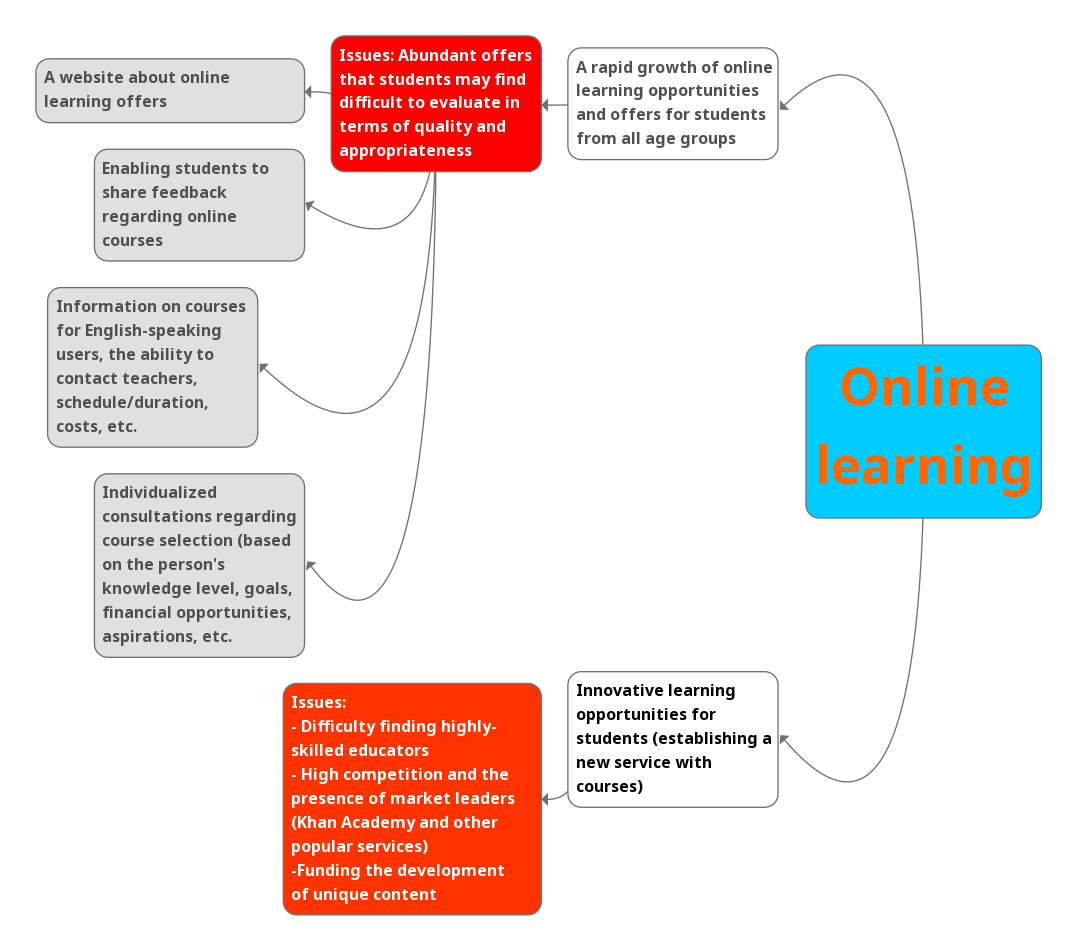Technique Identification
Week 2 paper has provided an overview of the industry of interest (the digital education market) and an example of one leading market player – Khan Academy. This assignment details the application of two solution generation techniques from the technique directory, including mind map creation and Edward de Bono’s Six Thinking Hats decision-making method. By promoting the depiction of hierarchical relationships between concepts, mind mapping can support graduality and consistency in opportunity identification and solving diverse issues, which makes it popular among business and design students (Sheppard, 2020).
De Bono’s method is based on exploring the issue of interest using six thinking techniques. Among them are the white hat (proven facts, data, and research), the yellow hat (benefits), and the red hat (excitement, feelings, and intuition) (Göçmen & Coşkun, 2019). Also, the model involves the blue hat (cool and well-considered decisions), the green hat (originality, innovation, and boldness), and the black hat (the focus on hazards and threats) (Göçmen & Coşkun, 2019). Figure 1 and Table 1 demonstrate the uses of the selected techniques.
How the Techniques Were Used
Technique 1
Table 1. The Six Thinking Hats Method Applied to Online Learning.
Technique 2

The Problem/Gap/Need
The previously identified problem in the digital education industry is the superabundance of online education opportunities. Many of them fail to promote tangible results and support students in becoming skilled professionals, which deals with various factors, such as educators’ skill levels, ineffective use of technology, or insufficient course duration. Considering the high demand for online education, enabling consumers to make better online course choices is pivotal to support the culture of professional excellence globally.
Explanation of Results and the Techniques’ Helpfulness
The selected techniques supported the identification of two major opportunities pertaining to entrepreneurship and online education. The first opportunity is creating a new online resource for all English-speaking students that would offer up-to-date and properly structured information on the various courses and skill development programs available online. The establishment of a new resource similar to Khan Academy would involve numerous disadvantages, including the need for investment, substantial human resources, and a strategy that would allow withstanding competition. In contrast to that, establishing an informational resource is still an opportunity due to the high demand for educational services and good skill development solutions during the pandemic (Ivanova et al., 2021).
The next opportunity is linked to the first one and involves organizing an online student orientation service to provide users with individualized recommendations regarding online courses that would support their personal and professional development goals. This idea is an opportunity since the increasing supply of digital education services may result in getting lost in endless offers and advertisements, and personalized advice from experts in the field of interest would prevent ill-considered education decisions.
The techniques supported the identification of the opportunities above in dissimilar ways. Due to the white, black, and blue hat components, the Six Thinking Hats strategy has promoted more realistic thinking when it comes to contributing to alleviating the problem. The establishment of a new online platform seems a high-risk decision given the current market leaders’ stability and ongoing success, and the green hat part has enabled me to think in a different direction (Koksal, 2020).
Interestingly, this technique’s effects on creativity have been proven empirically. In the experimental study by Göçmen and Coşkun (2019), the green thinking hat technique has been shown to increase students’ ability to produce unique ideas. By fostering systematic thinking, mind mapping activities have enabled me to analyze random ideas with reference to the ability to transform them into feasible opportunities. This led to the generation of four smaller ideas that could be put into practice in one large web resource.
References
Göçmen, Ö., & Coşkun, H. (2019). The effects of the six thinking hats and speed on creativity in brainstorming. Thinking Skills and Creativity, 31, 284-295. Web.
Ivanova, A. O., Ignatieva, T. A., & Pilyavsky, V. P. (2021). Trends, opportunities and perspectives of digital education development in the global economy. IOP Conference Series: Earth and Environmental Science, 666(3), 032033. Web.
Koksal, I. (2020). The rise of online learning. Forbes. Web.
Sheikh, M., Muhammad, A. H., & Hasan Naveed, Q. N. (2021). Enhancing usability of e-learning platform: A case study of Khan Academy. Sir Syed Journal of Education & Social Research, 4(2), 40-50. Web.
Sheppard, M. J. (2020). A case study of a radical constructivist approach to teaching innovation. Journal of Education for Business, 95(8), 559-566. Web.